In video games, a power-up is an object that adds temporary benefits or extra abilities to the player character as a game mechanic. This is in contrast to an item, which may or may not have a permanent benefit that can be used at any time chosen by the player. Although often collected directly through touch, power-ups can sometimes only be gained by collecting several related items, such as the floating letters of the word 'EXTEND' in Bubble Bobble. Well known examples of power-ups that have entered popular culture include the power pellets from Pac-Man and the Super Mushroom from Super Mario Bros., which ranked first in UGO Networks' Top 11 Video Game Powerups.

The Chaos Engine is a top-down run and gun video game developed by The Bitmap Brothers and published by Renegade Software in March 1993. The game is set in a steampunk Victorian age in which one or two players must battle the hostile creations of the eponymous Chaos Engine across four landscapes and ultimately defeat it and its deranged inventor.

Chaos Control is a rail shooter developed by Infogrames Multimedia and published by Philips Interactive Media for the CD-i, MS-DOS, Macintosh, Sega Saturn and PlayStation in 1995. The game's cutscenes are rendered in a style reminiscent of anime.

Stargate is a side-scrolling shooter game released for arcades in 1981 by Williams Electronics. Created by Eugene Jarvis and Larry DeMar, it is a sequel to Defender which was released earlier in the year. It was the first of only three productions from Vid Kidz, an independent development house formed by Jarvis and DeMar. Some home ports of Stargate were renamed to Defender II for legal reasons.
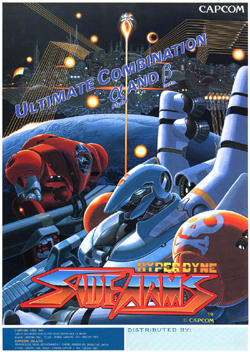
Hyper Dyne Side Arms (サイドアーム) is a horizontally scrolling shooter developed and released by Capcom as an arcade video game in 1986. The player takes control of a flying mecha fighter who must battle an alien army. Side Arms uses a two-directional attacking system similar to Capcom's previous shoot-'em-up Section Z.
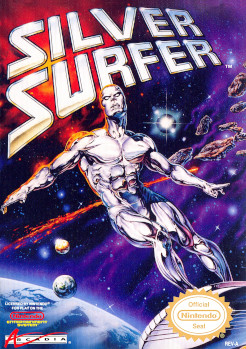
Silver Surfer is a 1990 scrolling shoot 'em up video game developed by Software Creations and published by Arcadia Systems. The game was released in November 1990 in the United States exclusively for the Nintendo Entertainment System. Silver Surfer is based on the Marvel Comics character Silver Surfer, and is primarily known for its high difficulty and highly praised music.
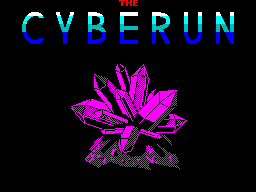
Cyberun is a ZX Spectrum video game by Ultimate Play the Game and published by U.S. Gold in 1986. Although not part of the Jetman series, it has similarities to Jetpac in that the player must construct their spaceship from parts, then seek out resources and power-ups.

Metal Slug is a Japanese multimedia franchise and run and gun video game series originally created by Nazca Corporation before merging with SNK in 1996 after the completion of the first game in the series. Spin-off games include a third-person shooter to commemorate the 10th anniversary of the series and a tower defense game for the mobile platform. Originally created for Neo-Geo arcade machines hardware (MVS) and the Neo-Geo home game consoles (AES) hardware, the original games have also been ported to other consoles and mobile platforms throughout the years, with several later games created for various other platforms. The games focus on the Peregrine Falcon Squad, a small group of soldiers who fight against a rebel army, aliens, zombies, mummies and various other forces intent on world domination.
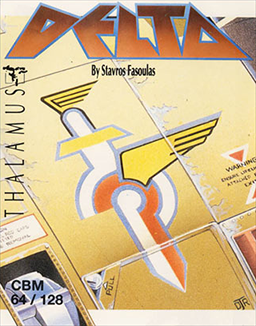
Delta is a horizontally scrolling shooter released for the Commodore 64 by Thalamus Ltd in 1987. It was programmed by Stavros Fasoulas and the music was written by Rob Hubbard. The game was published as Delta Patrol in the United States by Electronic Arts, for its Amazing Software line, in 1987 on the Commodore 64. It was also released for the ZX Spectrum in 1990 as Delta Charge.

Blasteroids is the third official sequel to the 1979 multidirectional shooter video game, Asteroids. It was developed by Atari Games and released in arcades in 1987. Unlike the previous games, Blasteroids uses raster graphics instead of vector graphics, and has power-ups and a boss.
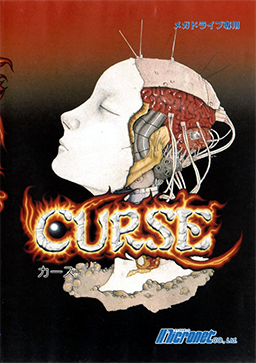
Curse is a 1989 video game developed by Micronet for the Mega Drive video game console. It is a horizontally scrolling shooter with five levels. Although an American release was planned, it was never officially released outside Japan.

Space Megaforce, known in Japan and Europe as Super Aleste, is a vertically scrolling shooter developed by Compile. It was published by Toho in 1992 for the Super Nintendo Entertainment System as part of the Aleste series. The player pilots a spacecraft through a variety of locales shooting enemy ships. The story in the Japanese version is different from the American and European one. Super Aleste also offers a "Short Game", with segments of the regular levels; the emphasis is on scoring as many points as possible.

Volfied is an arcade video game designed by Fukio Mitsuji and released by Taito in 1989. It is a successor to Qix, with extra features and a futuristic science fiction aesthetic, rather than Qix's abstract geometry style; the player pilots a small spaceship named "Monotros" instead of a Stix, and the enemies come in the form of various aliens.
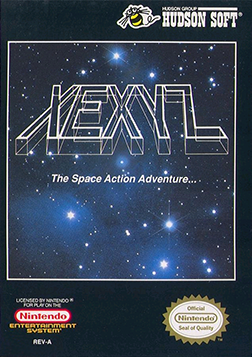
Xexyz, known in Japan as Kame no Ongaeshi - Urashima Densetsu, is a 1988 video game published by Hudson Soft for the Nintendo Entertainment System. The game was released in Japan on August 26, 1988, and saw a North American release sometime in April 1990. The game was never released in Europe and the game is not playable on PAL consoles.

Alien 3: The Gun is a 1993 rail shooter arcade game released by Sega. It is based on the film Alien 3, but focuses on two space Marines.
In pen and paper games and computer and video games, an item is an object within the game world that can be collected by a player or, occasionally, a non-player character. These items are sometimes called pick-ups.

Darwin 4078 is an arcade game released by Data East in 1986. The game is a vertical scrolling shoot 'em up like Xevious, but as the title indicates, Charles Darwin's theory of evolution is incorporated into the gameplay.

DarkOrbit, later renamed to DarkOrbit: Reloaded is a massively multiplayer online game developed by Bigpoint Games. The game is set in outer space, where players control a spaceship to battle against non-player characters and other players. It is a three-dimensional isometric Flash game with over 300 million registered accounts.

Falsion is an on-rail 3D shoot-'em-up produced by Konami that was released for the Family Computer Disk System in 1987. It is one of the few games compatible with the Famicom 3D System peripheral.

Radix: Beyond the Void is a 2.5D first-person shooter developed by Canadian studio Neural Storm Entertainment and published by Epic MegaGames for MS-DOS in 1995.

















